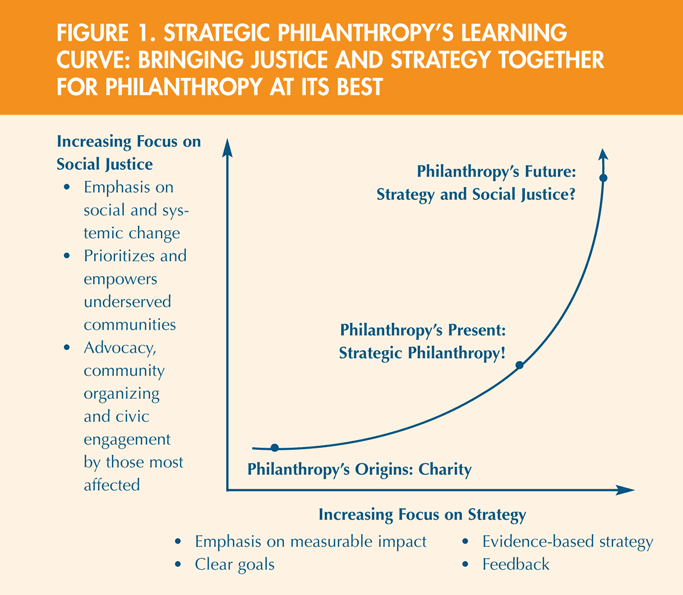There’s nothing simple about the innumerable social issues funders and nonprofits are trying to address every day. The crises affecting our nation and the world have prompted philanthropists to become more organized, focused and, perhaps above all, “strategic” in their efforts.
The movement toward “strategic philanthropy” has already contributed to greater philanthropic effectiveness. Yet, despite important contributions to education, health, the arts and the environment, the persistence, and in some cases exacerbation, of great disparities along the lines of class, race and gender suggest that philanthropy’s ultimate effectiveness is limited.
How can grantmakers boost the impact of their contributions to a more just society? The answer might well lie in fusing strategy and justice in the ecosystem of the nonprofit sector. Consider the interconnectedness of the issues that funders are addressing and it becomes clear that our sector functions much like any system such as the human body: if one part of it changes, the entire system is affected. Indeed, many of the issues that we are attempting to resolve individually are more often than not linked to each other. Heeten Kalan, senior program officer at the New World Foundation, recently penned a guest post where he noted that we cannot view any issue in isolation. Seemingly disparate issues are, in fact, interconnected in the ecosystem of our sector.
As my colleague Kevin Laskowski and I contend in NCRP’s recent publication, Real Results: Why Strategic Philanthropy is Social Justice Philanthropy, systems change requires a well-coordinated and resourced nonprofit ecosystem comprising grantmakers, grantees and the communities we are working to help.
Here are three things funders need to fuse strategy and justice:
a) A clear understanding of one’s goals includes identifying the desired impact and who will benefit from grantmaking and how.
b) A commitment to evidence-based strategy includes the positive, tangible impact – and frequently the necessity – of influencing public policy.
c) The input of those who stand to gain or lose the most from grantmaking, i.e., grantees and the communities they serve, to keep a philanthropic strategy on course.
To assess the current state of giving to underserved communities and social justice grantmaking, NCRP analyzed data from the Foundation Center from 2007 to 2010. NCRP’s analysis of grants intended to benefit vulnerable populations, broadly defined, across issues found that education funders reported 21 percent of grant dollars, health funders reported 39 percent, arts and culture funders reported 10 percent and environment and climate funders reported 15 percent of their grant dollars to benefit marginalized communities.
A similar analysis across the four issues of grants made with a social justice purpose found education funders reporting 6 percent, health funders at 11 percent, arts and culture at 4 percent and environment and climate funders at 11 percent. Although it is possible that some foundations do provide monies in these ways but do not report them or code them accurately, the analysis provides a solid picture of the state of giving to underserved communities and social justice.
Additionally, grantmakers would see more impact if they looked past issues of interest – without foregoing an issue-specific focus – to other issues and find ways in these interact and overlap.
NCRP’s report for environment and climate grantmakers Cultivating the Grassroots: A Winning Approach for Environment Funders documented the work of Kentuckians for the Commonwealth (KFTC), a 30 year-old state-wide membership organization that works on advancing social, environmental and economic justice at the local, state and national levels. KFTC provides technical workshops, builds alliances with other grassroots organizations in various states and trains community members in basic organizing skills.
As a funder of KFTC and a member of the environment report’s advisory committee, Heeten explains that KFTC is “working with thousands of its members to connect issues of criminal justice to jobs to the environment to people’s livelihoods and community resilience. They make the connections their members make the connections. Why can’t funders make those connections and start funding outside our narrow silos? We are going to need more than just the traditional environmental organizations to get anywhere, and it is time for the philanthropic community to look beyond traditional environmental organizations.”
As noted in Cultivating the Grassroots, being part of a funder affinity group allows its members to help advance a more transformative, accountable and effective sector. Members practice truly strategic philanthropy. A focus on people and communities, which is a constituency that grantmakers traditionally do not engage with because they appear so different than funders, is what makes their strategy just.
Working across issues to address a specific problem is not only feasible but also increases the chances that grantmakers and grantees achieve their goals as it helps mitigate rigid disparities among our communities in a sustainable and inclusive way.
When philanthropy acknowledges the nexuses of various issues, uses a social justice lens in developing strategy and focuses on the most underserved among us, it is strategic philanthropy at its best.
Niki Jagpal is the research and policy director at the National Committee for Responsive Philanthropy (NCRP). She blogs frequently about philanthropy and social justice.

